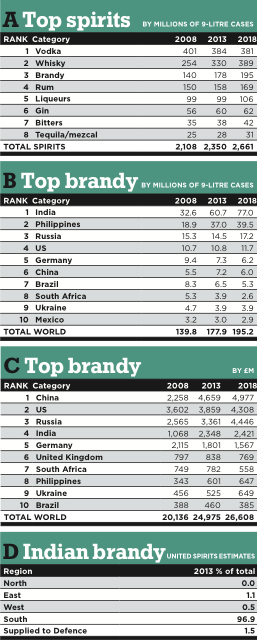....................................................
CLARET IS THE LIQUOR FOR BOYS; PORT FOR MEN; BUT HE WHO ASPIRES TO BE A HERO MUST DRINK BRANDY,” Samuel Johnston once remarked, apparently smiling as he did. If the British writer lived today he’d guffaw at annual brandy consumption. Measuring 178m 9-litre cases a year, it is the third most consumed international spirit in the world – there’s enough brandy to make heroes of many men.
Notably, the author of the 1755 A Dictionary of the English Language omitted brandy from his famous lexicon – but perhaps he, as commentators today, struggled with its definition.
Brandy has as many styles as it has qualities and as a result draws binary review. It is made in practically every wine-producing region of the world, and is even found in and around the tropics, a climate in which vines are not known to prosper. It’s safe to say that not all countries live by the western definition that brandy should be distilled from grape or fruit juice.
Producers in the category’s largest markets – India and the Philippines – certainly have a more liberal interpretation (one that involves a fair amount of neutral spirit made from sugar cane). But industry data researchers and commentators alike have got into the habit of rationalising that, if it is sold as brandy, it is brandy. There is a little too much brandy under the bridge to correct the record here.
So, with this malleable definition in mind, the category’s consumers too couldn’t be more different, ranging from the millions of local brandy consumers of southern India and the Philippines to cognac fans, whether they be African Americans, Russians, Nigerians or the clichéd connoisseur.
Growth
As a category, brandy is growing. Euromonitor International (which supplied all data for tables A, B and C) forecasts volume will swell 10% between 2013-2018 (see table A), maintaining its position as the third-largest international category, but this growth is coming from two major markets.
In volume terms at least, India is at the vanguard of development. As the country’s population expands and society continues to liberalise, so will its pool of drinkers (about a third of India’s 1.3bn do not drink due to religious reasons or societal stigma). In India, brandy drinking is a southern state habit (see table D), with 96.9% of the annual 61m cases of consumption occurring there, according to United Spirits estimates.
India is home to United Spirits’ McDowell’s No 1, which stumbled in 2013, shedding 15% of its volumes. At 9.3m cases it remains the heavyweight. Meanwhile, Old Admiral hoovered up sales to the tune of an 11% increase, though it is still well back at 3.9m cases.
Men’s Club’s 1,000% increase from 0.3m cases to 2.9m cases in one year was the growth story of the year – and a swing only possible among United Spirits’ moving carousel of brands. Suresh Menon, executive vice president of planning & control at United Spirits, explains how. “The growth of Men’s Club is specific to one of the states in South India, Tamil Nadu. We de-emphasised one of our brands, Golden Grape brandy, and introduced Men’s Club.” He says Men’s Club has benefitted from favourable consumer response and Golden Grape’s ‘de-emphasis’.
India is expected to increase value by 3% from 2013-2018, so will remain a low-value, high-volume market for the foreseeable. Bottle sales are likely to increase 27% over the five-year period, according to Euromonitor International, with its category share increasing from 34% to 39%.
But these projections could be derailed by Prohibition in the southern state of Kerala. An alcohol ban imposed in 2014 was later tempered after hotels and bars argued that a dry state would harm tourism. Probably the compromise will protect tourists from alcohol-free holidays and Keralans from readily available alcohol. But as India’s wettest state – reportedly 20% of the state’s revenues come from alcohol – what happens here has a profound effect on the category’s health.




